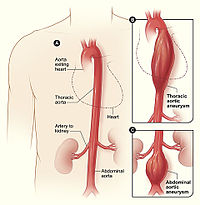
Photo from wikipedia
Purpose: To define the treatment response and long-term outcomes of a large IgG4-related ophthalmic disease (IgG4-ROD) cohort. Methods: A total of 132 patients with a minimum follow-up of 1 year… Click to show full abstract
Purpose: To define the treatment response and long-term outcomes of a large IgG4-related ophthalmic disease (IgG4-ROD) cohort. Methods: A total of 132 patients with a minimum follow-up of 1 year were included in this study. Demographic, clinical, and laboratory data were collected. Treatment response was assessed by the IgG4-RD responder index (IgG4-RD RI). Risk factors for relapse were analyzed with the multivariate Cox regression analysis. Results: The median follow-up time was 39 months. Lacrimal gland involvement was detected in 87.9% of cases. Extraocular muscles, the trigeminal nerve, and other soft tissue were affected in 25.8, 6.1, and 18.2% of patients. The relapse rate of watchful waiting, glucocorticoid monotherapy, immunosuppressant monotherapy, and combination therapy was 50.0, 51.7, 50.0, and 26.7% (p = 0.038), respectively. The combination therapy group exhibited shorter glucocorticoids therapy duration (36 vs. 48 months, p = 0.009) and maintenance period (24 vs. 42 months, p = 0.003). At the 6th month, the median IgG4-RD RI declined from 12 to 1 and 105 (79.5%) patients achieved complete response (CR). Relapse occurred in 49 (37.1%) patients. The multivariate Cox regression analysis exhibited that CR at the 6th month was an independent protective factor for relapse. Patients with multiple ocular lesions suffered from a higher risk of relapse. No patient had severe adverse reactions to the treatment in this study. Conclusion: Relapse was common in patients with IgG4-ROD. Patients receiving combination therapy showed a lower relapse rate and a shorter glucocorticoids therapy period. The presence of multiple ocular lesions was associated with a higher risk of relapse. CR at the 6th month might be a predictor for a better prognosis in IgG4-ROD. Thus, a more aggressive regimen should be prescribed for patients with a poor initial response.
Journal Title: Frontiers in Medicine
Year Published: 2021
Link to full text (if available)
Share on Social Media: Sign Up to like & get
recommendations!